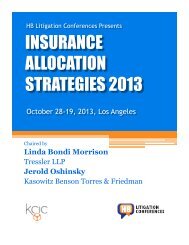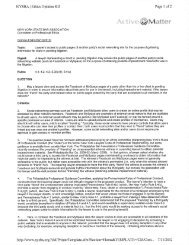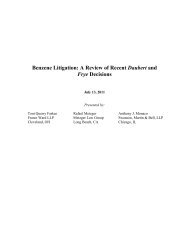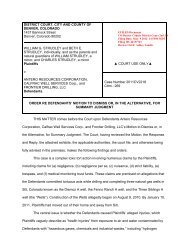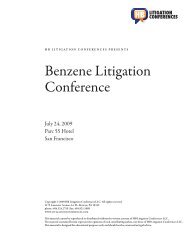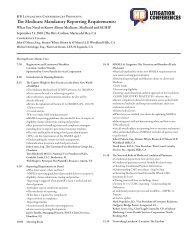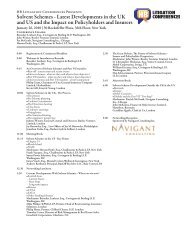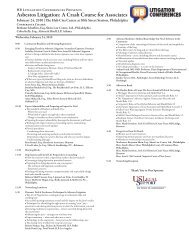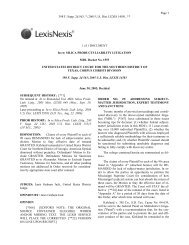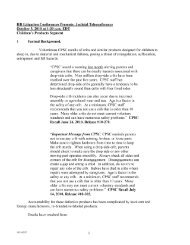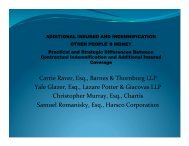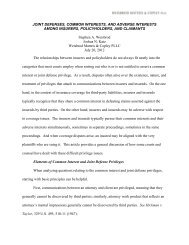Is My Drywall Chinese? - HB Litigation Conferences
Is My Drywall Chinese? - HB Litigation Conferences
Is My Drywall Chinese? - HB Litigation Conferences
Create successful ePaper yourself
Turn your PDF publications into a flip-book with our unique Google optimized e-Paper software.
able, in which case rather than a<br />
“market value,” the property may have<br />
some “value in use.” Be on the lookout<br />
for extended marketing times for<br />
properties that have defective drywall<br />
or that have had defective drywall<br />
replaced. Extended marketing times can<br />
result in lost opportunities and<br />
increased holding or marketing costs.<br />
2. If an owner of a stigmatized house<br />
wants to sell it and acquire a replace‐<br />
ment home, but must sell the stigma‐<br />
tized house in order to be able to close<br />
on a replacement home, they may not<br />
be able to convince a seller of a<br />
potential replacement homes to extend<br />
the closing while they market the<br />
stigmatized home. If the seller of a<br />
stigmatized home has to hold it for an<br />
extended period of time after having<br />
moved out, the excess cost of holding is<br />
measurable.<br />
3. The cost of marketing stigmatized<br />
properties can be significantly greater.<br />
One real estate broker we know<br />
charges a consulting fee for assisting<br />
property owners through the process of<br />
preparing a contaminated property for<br />
sale. This broker works with environ‐<br />
mental consultants to identify the<br />
extent of contamination and to<br />
develop, and sometimes implement, a<br />
remediation plan that can be evaluated<br />
by the state. All this is done before a<br />
property is ever listed.<br />
4. Institutional controls. Stigmatized<br />
properties may be subject to additional<br />
governmental controls. While we are<br />
unaware of any institutional controls<br />
being added for properties with<br />
defective drywall, we have observed<br />
them in other contaminated properties.<br />
For example, a brownfield property that<br />
has been remediated by capping<br />
SUITE 650, FOURTH AVENUE<br />
SEATTLE, WASHINGTON 98121<br />
PHONE 206-623-2935 FAX 206-623-2985<br />
HTTP://WWW.GREENFIELDADVISORS.COM<br />
<strong>Chinese</strong> <strong>Drywall</strong><br />
June 5, 2009<br />
Page 5<br />
contaminated soil with a layer of<br />
uncontaminated soil requires approval<br />
from the state before excavating below<br />
the cap.<br />
5. Lower prices. Stigma may result in<br />
lower prices for impaired properties. To<br />
be attributed to stigma, this loss in<br />
value must be greater than the cost of<br />
remediation or must persist after the<br />
remediation has been completed. For<br />
example, homes with asbestos insul‐<br />
ation or siding may have restrictions on<br />
remodeling or on use of the attic.<br />
6. Disclosure requirements. To date<br />
disclosure has not been mandated by<br />
any state, however many realtor<br />
associations are moving on this of their<br />
own accord. In Sarasota, for example, a<br />
disclosure form relating specifically to<br />
<strong>Chinese</strong>‐manufactured drywall has<br />
been introduced.<br />
Measuring Effects of Stigma<br />
Given the large body of literature on the topic<br />
of stigma, this paper will simply provide a brief<br />
primer. (See www.GreenfieldAdvisors.com for<br />
additional reading and information about<br />
stigma.)<br />
Generally, stigma is measured is by comparing<br />
the loss in value from an unimpaired state to an<br />
impaired state to detect the total loss in value.<br />
A further deduction for the cost to remediate<br />
(i.e., effect a feasible cure) is included to yield<br />
the loss in value attributable to stigma. Residual<br />
stigma can be calculated as the change in value<br />
between an impaired property and the same<br />
property after remediation has been<br />
implemented. In these kinds of appraisals, it is<br />
useful to consider how the results of the<br />
findings will be applied. This leads the way that<br />
the research and analysis program is designed.<br />
Traditionally, the loss in value is calculated as a<br />
percentage of an unimpaired value before



